In the misty uplands of Waimea, through the rolling pastures of Molokaʻi, and across the sprawling ranches of upcountry Maui, a powerful legacy lives on—that of the paniolo, Hawaii’s cowboys. While many recognize them for their rugged horsemanship and contributions to island ranching, few understand the depth of their impact on Hawaiian identity. Beyond wrangling cattle and riding horseback, the paniolo were instrumental in preserving Hawaiian language and culture during one of the most turbulent eras in the islands' history.
The story begins in the early 19th century. After British explorer George Vancouver gifted cattle to King Kamehameha I in the 1790s, those animals multiplied unchecked, becoming a growing threat to farmland and forests. To manage the explosive cattle population, Kamehameha III (Kauikeaouli) invited experienced Mexican vaqueros—Spanish-speaking cowboys from California—to the Hawaiian Islands in the 1830s.
These vaqueros brought with them expertise in ranching, roping, saddle-making, and horsemanship. Hawaiian men were quick learners, absorbing these new skills and adapting them to their own environment. Over time, the Hawaiian term paniolo, believed to derive from “Español,” came to represent this new breed of cowboy—one who blended Hawaiian tradition with Mexican technique.
But the influence of these vaqueros ran deeper than the physical skills they taught. They shared a way of life grounded in respect for the land, strong family ties, music, and storytelling—values that mirrored those in traditional Hawaiian society. The result was not just a new profession, but a new cultural identity: the paniolo, proud stewards of the land (kuleana) and protectors of Hawaiian spirit.
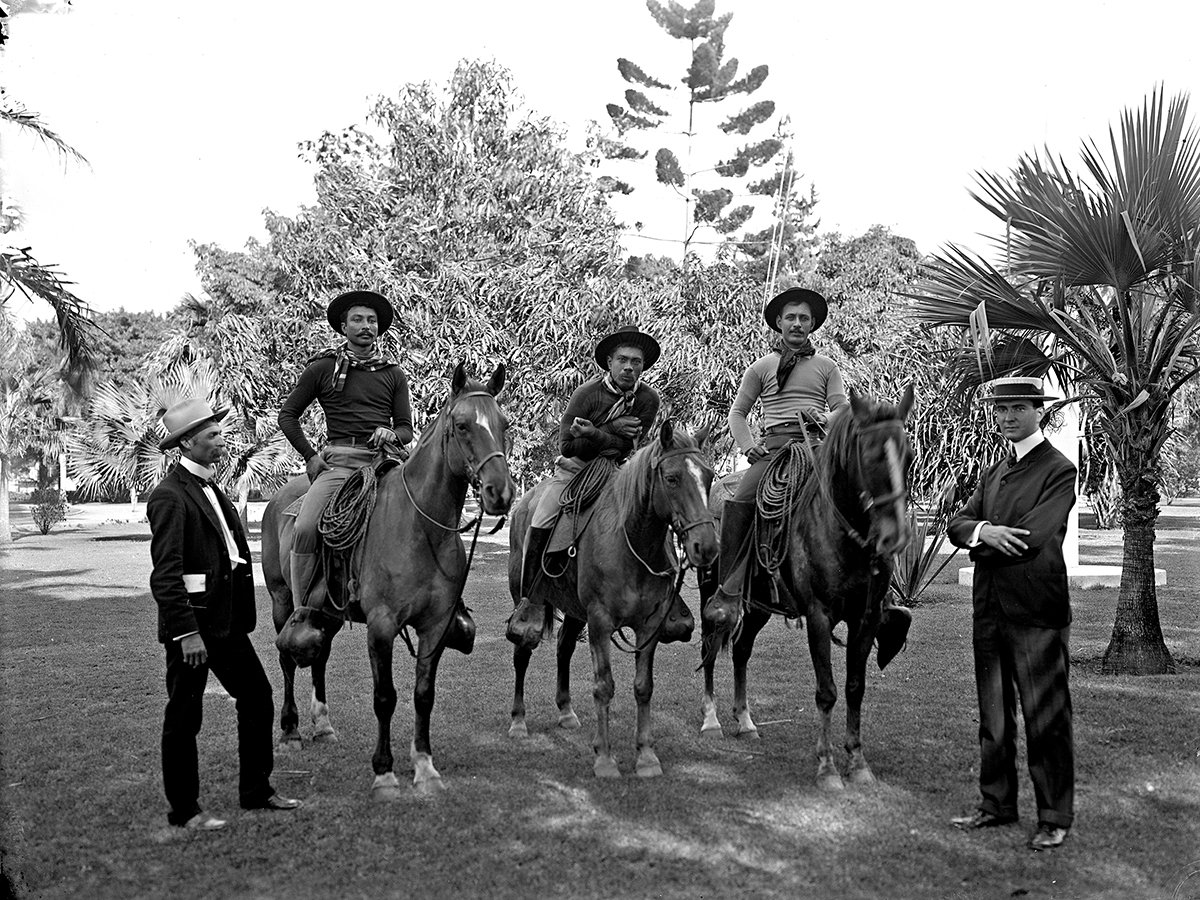
While the paniolo helped birth a thriving ranching economy, their most profound contribution may have come decades later, when Hawaiian identity faced near erasure.
Following the illegal overthrow of the Hawaiian Kingdom in 1893 and the subsequent annexation by the United States in 1898, sweeping changes were forced upon the islands. In 1896, Hawaiian was banned as a language of instruction in schools. Speaking the language in public was discouraged or outright punished sometimes, punishable by death. English-only policies became a tool of cultural suppression, designed to assimilate Native Hawaiians into Western norms.
In cities and towns, this pressure took its toll. Hawaiian children were discouraged from speaking their mother tongue, and generations began to grow up without fluency in their native language. But in the countryside—on the remote ranches of Hawaiʻi Island, Molokaʻi, and Maui—the story was different.
The paniolo lived far from government centers and urban control. On the ranches, Hawaiian remained the language of daily life. Cowboys spoke Hawaiian in the fields, at home, in song, and in prayer. Oral traditions, chants (oli), and ancestral knowledge were passed from parent to child without interruption. These ranchlands became cultural sanctuaries, where Hawaiian identity endured in spite of official efforts to silence it.
The paniolo didn’t set out to be activists or revolutionaries—they simply lived according to the values of their ancestors. In doing so, they kept the language alive when it was outlawed. They kept aloha ʻāina—love of the land—at the core of their daily lives. They upheld ʻohana—family—and the importance of story and song. And perhaps most powerfully, they maintained a sense of pride in being Hawaiian, even when the dominant culture tried to erase it.
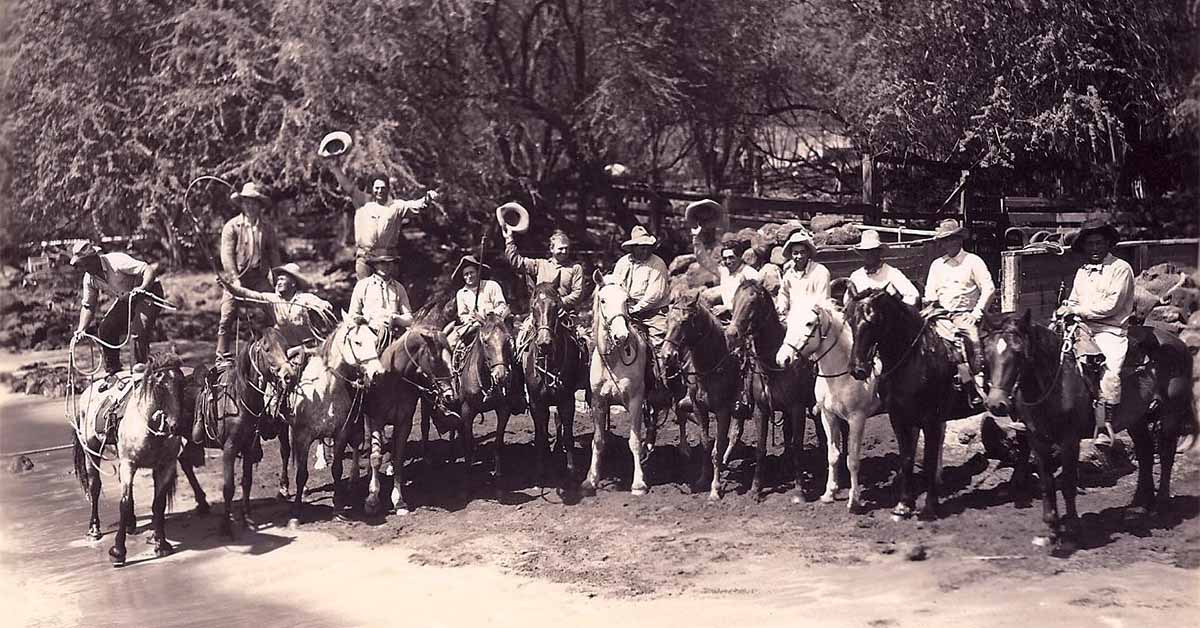
The legacy of the paniolo endures today not just through ranching, but through rodeo culture, which remains vibrant in rural Hawaiʻi. These events—held annually in towns like Makawao, Waimea, and Kaunakakai—are more than just competitions. They are celebrations of identity, where Hawaiian language is spoken freely, and traditions are proudly displayed.
Slack-key guitar and mele paniolo (cowboy songs) echo through the air, telling stories of hardship, humor, and heritage. Rodeos serve as modern spaces where Hawaiian values and community thrive—further testament to the paniolo’s role in cultural preservation.
If you are interested in booking tickets or more information on the Makawao Rodeo here are links to booking, etc.
Bookings: oskiericeeeventcenter.com
Information: https://bossfrog.com/makawao-rodeo/general/
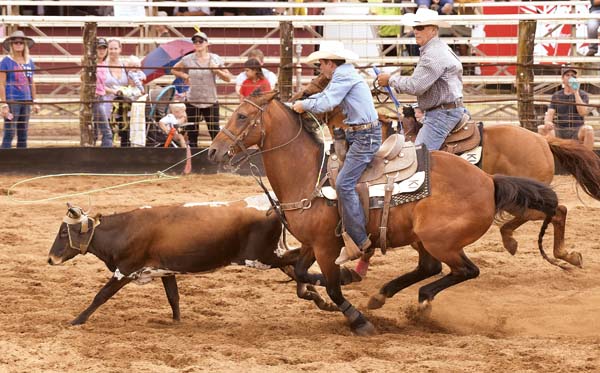
When the Hawaiian Renaissance began in the 1970s—a movement aimed at restoring language, culture, and sovereignty—it found that the roots had never been fully lost. In part, that was thanks to the paniolo. The oral language, still spoken fluently by many elder cowboys, became a lifeline for linguists and educators rebuilding curriculum for Hawaiian language immersion schools. The values embedded in paniolo life—self-reliance, stewardship, and storytelling—matched perfectly with the goals of the movement.
Today, many Hawaiian immersion programs and cultural centers recognize the contribution of paniolo families in preserving the language. Elders who once roped cattle are now seen as cultural heroes—unintentional but vital defenders of Hawaiian heritage during a time of crisis.
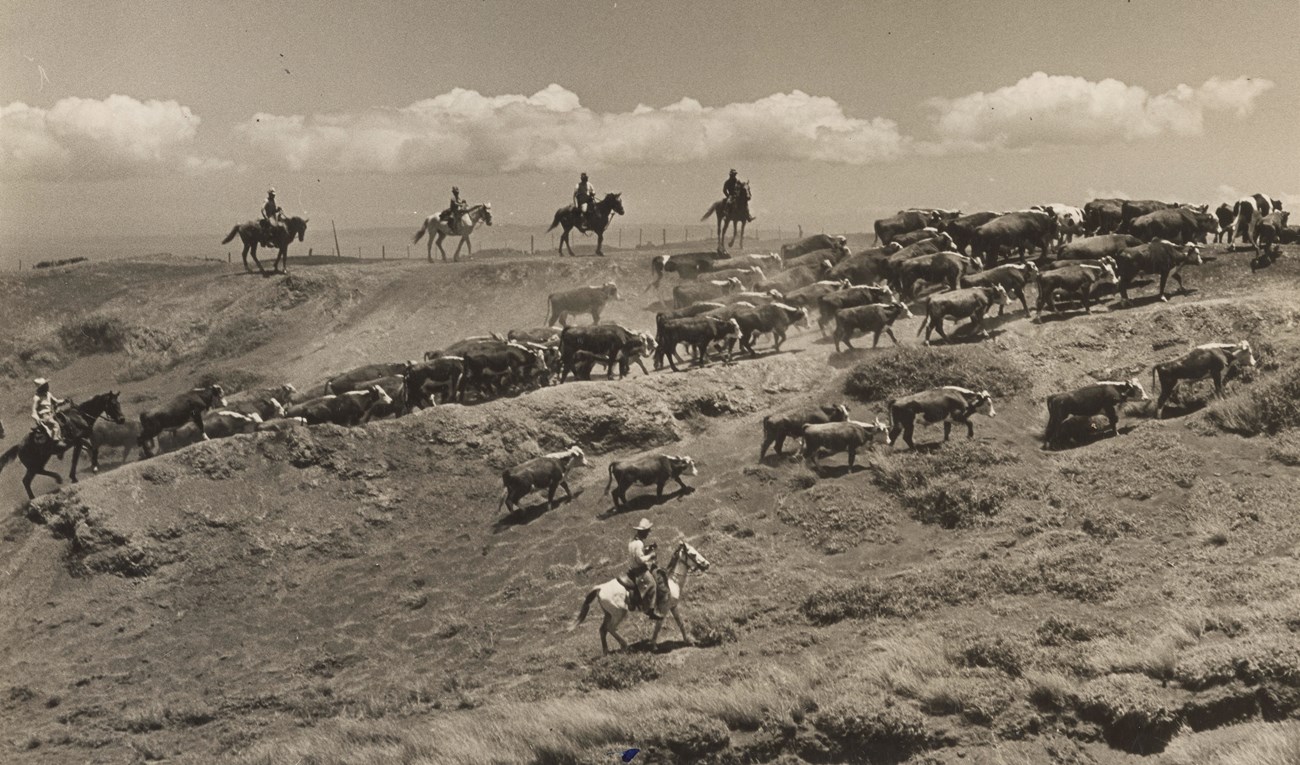
The story of the paniolo is not just about cattle or cowboy hats. It’s about resilience. It’s about a group of people who, through quiet strength and cultural pride, preserved a language and identity that others tried to erase. The legacy of the Mexican vaqueros lives on through them, but the spirit of the paniolo is deeply, undeniably Hawaiian.
So next time you hear a cowboy song in Hawaiian, see a young rider at a rodeo, or visit the open pastures of upcountry Maui, remember: you're witnessing the continuation of a legacy that refused to be silenced.
Here is a link to the many other blogs about and of Hawai'i / Maui:
Perched over 10,000 feet above sea level, Haleakalā Crater in Maui offers one of the most extraordinary stargazing experiences on Earth. This dormant volcano, located within Haleakalā National Park, is renowned for its pristine night skies, minimal light pollution, and breathtaking celestial views. Whether you're an amateur astronomer, a seasoned stargazer, or simply seeking a unique adventure, Haleakalā's summit provides an unforgettable encounter with the cosmos.
Haleakalā's summit stands at 10,023 feet, placing it above a significant portion of Earth's atmosphere. This elevation, combined with the area's dry air and isolation from urban light sources, creates optimal conditions for observing stars, planets, and deep-sky objects. The name "Haleakalā" means "House of the Sun" in Hawaiian, and according to local legend, the demigod Māui lassoed the sun from this very summit to slow its journey across the sky.
The crater itself is an erosional valley nearly 7 miles across, 2 miles wide, and 2,600 feet deep. Its unique geological features and high elevation contribute to the area's exceptional visibility, making it a prime location for both amateur and professional astronomers.
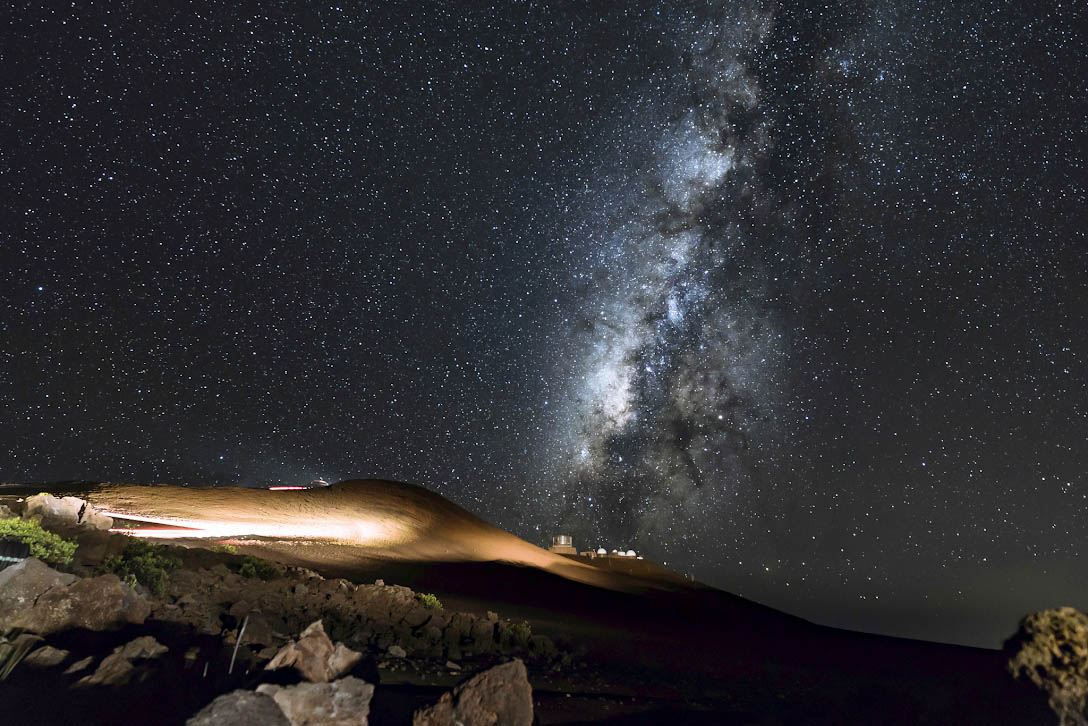
For those who prefer a self-guided experience, Haleakalā National Park welcomes visitors to stargaze from the summit. The park's high elevation and remote location offer some of the darkest skies in the United States. However, it's essential to come prepared: temperatures can drop into the 40s or lower, even during summer months. Dress in layers, including a windproof outer layer, and consider bringing gloves, a hat, and a blanket for added warmth.
A red flashlight is recommended to preserve night vision, and a reclining chair can enhance comfort during extended viewing sessions. Remember to allow your eyes at least 30 minutes to adjust to the darkness for optimal stargazing.
Please note that overnight stays within the park are only permitted in designated campgrounds, such as Hosmer Grove Campground in the summit district. Sleeping in vehicles outside of these areas is prohibited. Here is a direct link to book at Hosmer Grove if you plan to view the cosmos.
https://www.recreation.gov/camping/campgrounds/10068557
Here is a video about the sunset and stargazing atop the world!
For a more structured experience, several tour operators offer guided stargazing adventures on Haleakalā. These tours often include transportation, expert commentary, and high-powered telescopes for an in-depth exploration of the night sky.
Maui Stargazing provides an extensive tour of Haleakalā National Park, featuring a scenic sunset picnic followed by a science-based telescope adventure. Guests can observe visible planets and deep-sky objects of the Milky Way, including nebulae and star clusters, through a 12-inch aperture Dobsonian telescope. The tour includes winter jackets, fleece hats, gloves, and insulated snow pants to ensure comfort during the chilly evening hours.
https://www.mauistargazing.com/
Maui All Stars offers a sunset and stargazing tour that allows guests to observe the moon, stars, and galaxies using a large GPS telescope and laser pointer. The experience is hosted by an expert guide and includes convenient pick-up locations around the island.
https://www.hawaiiactivities.com/en/hawaii/maui/a/176011
Plan Ahead: Check the weather forecast before your trip, as conditions can change rapidly. Also, familiarize yourself with the park's regulations and obtain any necessary permits or reservations in advance.
Haleakalā holds deep spiritual significance for Native Hawaiians, who consider the summit a sacred place used for religious ceremonies and connecting with ancestors. Visitors are encouraged to approach the area with respect and mindfulness, honoring its cultural importance. Recent proposals to construct new telescopes on the summit have faced opposition from the local community, highlighting the need to balance scientific exploration with cultural preservation.
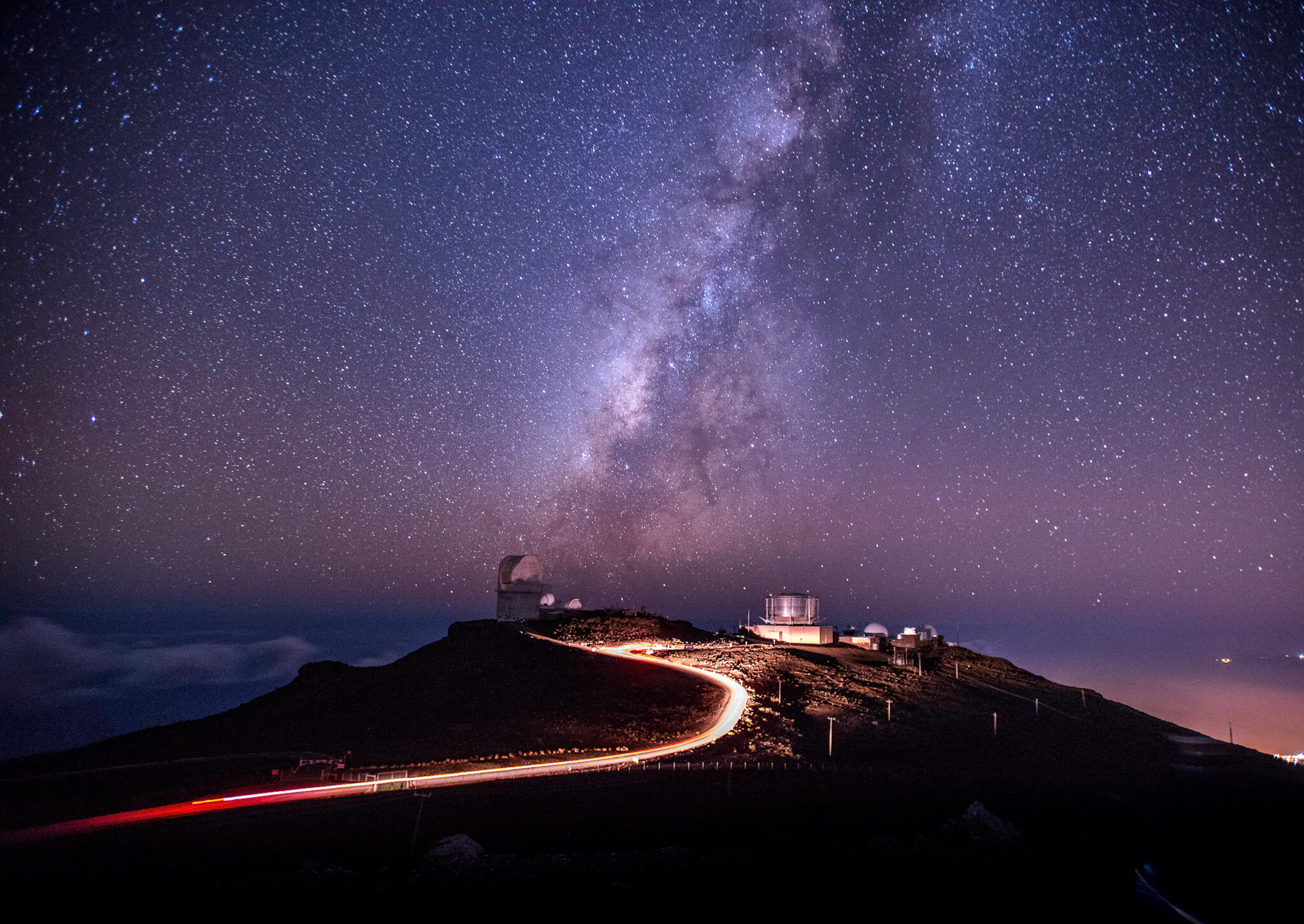
Stargazing at Haleakalā Crater is more than just a visual delight; it's a profound experience that connects you with the universe and the rich cultural tapestry of Hawaii. Whether you choose a guided tour or a self-directed adventure, the summit offers an unparalleled opportunity to witness the wonders of the night sky in a setting of natural and spiritual grandeur.
Here are the many informational blogs about life on Maui, Hawaii and the many things to do:
Language is more than a means of communication—it is a reflection of culture, history, and identity. Nowhere is this more evident than in Hawaii, where a unique form of English-based creole known as "Pidgin" has evolved over the past century. Officially referred to as Hawai‘i Creole English, Pidgin is a rich, dynamic language that encapsulates the multicultural heritage of the islands. Its development is deeply tied to Hawaii's complex social, economic, and cultural history, particularly during the plantation era. Today, while sometimes misunderstood, Pidgin remains a vital and expressive part of local identity.
The roots of Pidgin in Hawaii can be traced back to the mid-19th century, during a period of significant immigration and economic transformation. Following the decline of the whaling industry, Hawaii shifted toward an agricultural economy dominated by sugarcane and pineapple plantations. These plantations required a large labor force, which led to an influx of workers from China, Japan, Portugal, Korea, the Philippines, Puerto Rico, and other parts of the world.
These immigrant groups, each speaking their own languages, had to find ways to communicate with one another and with English-speaking plantation owners. This necessity gave birth to a rudimentary contact language—an early form of Pidgin—that incorporated vocabulary primarily from English, with grammatical influences from Hawaiian, Japanese, Portuguese, Cantonese, and other languages. At this stage, the language was not yet fully developed or standardized; it functioned mainly as a tool for basic communication.
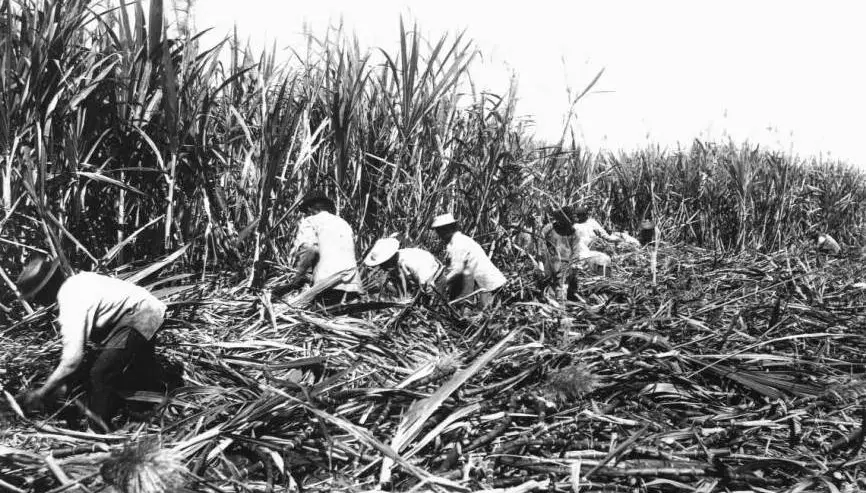
Over time, as immigrant families settled and generations were born and raised in Hawaii, Pidgin evolved from a simple trade language into a fully developed creole. By the early 20th century, children growing up in multilingual communities began acquiring Pidgin as their first language. This generational shift marked the transformation from a pidgin (a simplified language used for specific purposes) into a creole (a native language with its own stable grammar and vocabulary). For example, instead of saying "He is going to the store," a Pidgin speaker might say, "He stay going store.", another example is many here in Hawaii will say "close the light", instead of "Turn off the light.
Here is a short video talking about the origins of pidgin in Hawaii:
Here is a website that features some of the most common pidgin terms used in Hawaii:
For many in Hawaii, Pidgin is more than a way of speaking—it is an expression of local identity and solidarity. It reflects shared history, values, and a sense of place. It often carries nuances and cultural references that are difficult to translate into standard English. As such, Pidgin is commonly used in informal settings, storytelling, comedy, local literature, and even political discourse to connect authentically with local audiences.
Pidgin is a linguistic treasure that tells the story of Hawaii’s multicultural roots and the resilience of its people. Born out of necessity, shaped by diversity, and sustained by community, it continues to thrive as a powerful marker of identity and cultural pride. As public understanding and appreciation grow, Pidgin stands as a testament to Hawaii’s rich linguistic tapestry—one that deserves both recognition and respect.
Our website features more blogs about life in Hawaii, whether is on the history, culture, and activities!
Sitting along the emerald hills of Maui’s lush north shore lies Haiku, a charming upcountry village that offers a refreshing alternative to the island’s busy beach resorts. Known for its misty jungles, rolling pastures, and laid-back vibe, Haiku is a hidden gem that draws in adventurers, artists, and travelers seeking authentic connection — to nature, culture, and themselves.
Whether you’re planning a full stay in Haiku or a quick detour off the Road to Hana, this peaceful community has much to offer. Here's how to make the most of your time in Haiku, Maui.
Kick off your adventure with a visit to Twin Falls, one of the most accessible and rewarding waterfall hikes on the island. Located just past mile marker 2 on the Road to Hana, this easy-to-moderate trail weaves through bamboo forests, guava trees, and muddy jungle paths to reach a series of waterfalls and swimming holes.
Pack water shoes and a towel — and don’t be afraid to get wet! Local vendors near the trailhead often sell fresh coconuts and smoothies, perfect for a post-hike refresh.
At the heart of the village is the Haiku Marketplace, a community hub filled with local food, art, and character. Set in the historic Haiku Cannery building, the marketplace includes health-conscious eateries, a kombucha bar, artisan boutiques, a surf shop, and a well-stocked general store.
Try a locally sourced poke bowl, sip on small-batch kombucha, or grab a handmade gift to remember your trip. The vibe is casual, friendly, and authentically Maui.
No visit to Haiku is complete without a meal at Colleen’s at the Cannery, a beloved local staple located in the historic Haiku Cannery building. This laid-back café and bar serves up hearty breakfasts, fresh island-inspired lunches, and cozy dinners — all with a focus on quality ingredients and welcoming service.
Whether you’re fueling up before a waterfall hike or winding down after a day on the Road to Hana, Colleen’s offers something for everyone. Locals rave about the banana macadamia nut pancakes, wood-fired pizzas, and daily fish specials. The open-air seating, rustic charm, and local artwork make it a perfect spot to soak in the upcountry vibe.
Bonus: The espresso bar and cocktail menu are just as good as the food.
Haiku’s lush landscape is best explored with the help of local guides who know the trails and hidden gems. Eco-adventure tours offer a chance to hike off the beaten path, explore secret waterfalls, swing into jungle pools, and learn about native Hawaiian flora and history.
Whether you’re a family with kids or a solo explorer, these tours provide safe, insightful access to Haiku’s wild beauty — often with fresh fruit picked right from the trail.
For adrenaline with a view, NorthShore Zipline in Haiku delivers an unforgettable experience. Set on a historic World War II base in the lush upcountry jungle, this family-friendly zipline tour features seven lines, sky bridges, and soaring platforms with panoramic views of Maui’s north shore.
It’s the perfect mix of adventure and natural beauty — with expert guides, a safe and fun environment, and just enough thrill to keep your heart racing. Great for first-timers and seasoned zipliners alike, NorthShore Zipline is a must-do for anyone looking to add excitement to their Haiku itinerary.
Check out tour availabilities here!
Though technically just outside Haiku in nearby Paia, Ho’okipa Beach Park is an essential stop. Known as a global windsurfing mecca, it also offers jaw-dropping views of the coastline and excellent sea turtle spotting — especially in the late afternoon.
Bring a camera and take a walk down to the beach where you’re likely to see dozens of honu (Hawaiian green sea turtles) basking on the sand.
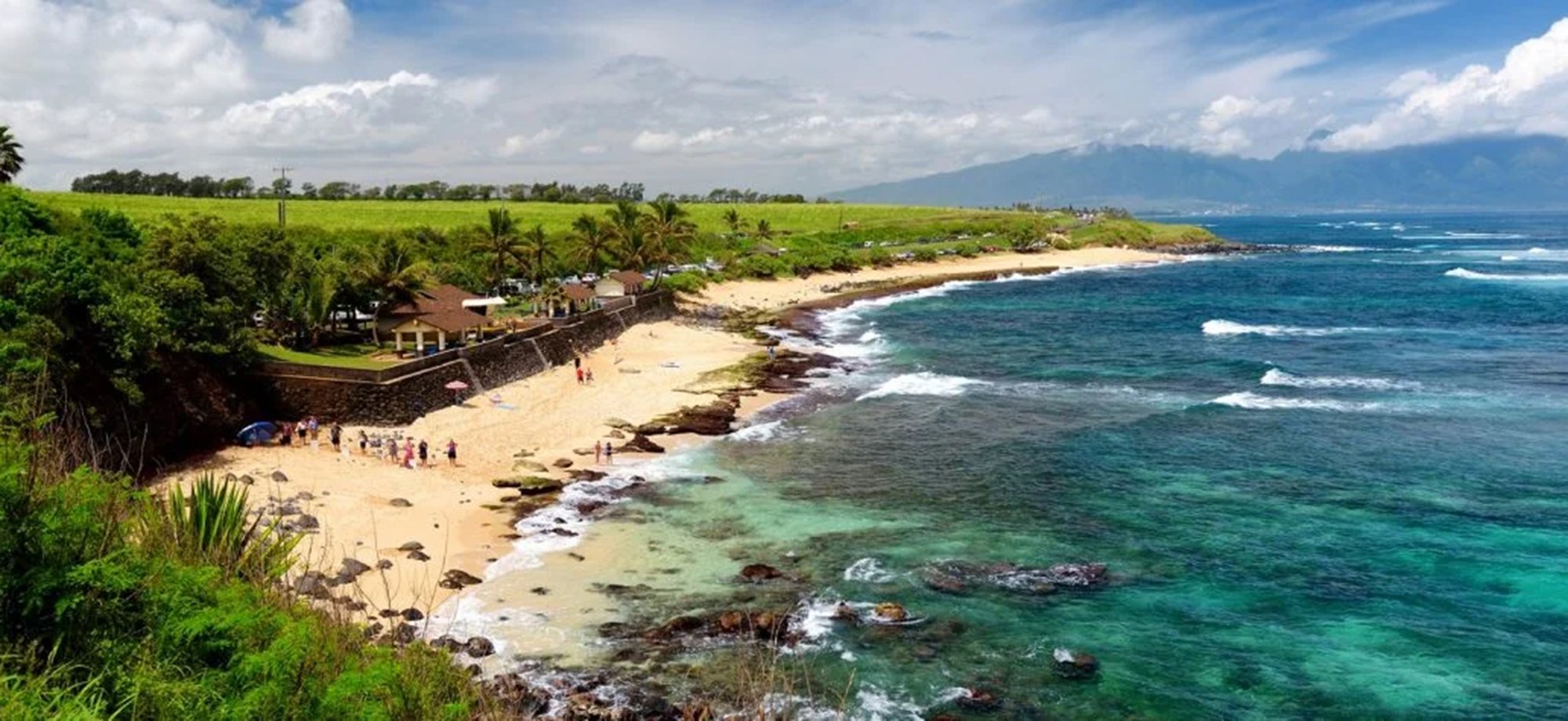
Haiku is home to a vibrant community of yogis, healers, and wellness seekers. It’s not uncommon to find yourself attending a sunrise yoga session overlooking a jungle valley, or joining a sound healing circle beneath the stars.
Many local retreat centers and eco-lodges offer single-day experiences or longer stays focused on mindfulness, nature connection, and self-care. Whether you're looking to deepen your practice or simply unwind, Haiku is a sanctuary for the soul.
Haiku serves as a perfect starting point for the legendary Road to Hana — one of the world’s most scenic drives. If you’re short on time or not ready to brave the full route, just exploring the early portion from Haiku offers lush vistas, waterfalls, botanical gardens, and coastal lookouts.
Be sure to drive carefully — the roads are narrow and winding, but the rewards are immense. Starting early from Haiku gives you a head start on the crowds.
Haiku may be small, but it packs a flavorful punch. From Thai food trucks to vegan cafés and fresh fruit stands, there’s no shortage of delicious options. Try local specialties like taro chips, lilikoi (passion fruit) treats, or fresh-baked banana bread.
For an unforgettable evening, check out Nuka, a beloved Japanese restaurant known for sushi made with locally caught fish and seasonal island ingredients. Reservations recommended — this spot is a favorite among locals and visitors alike.
Haiku is more than a place — it’s a feeling. A slow-paced, rain-kissed, quietly magical corner of Maui where life flows with the rhythms of the land. Here, you’ll trade crowded beaches for bamboo trails, loud nightlife for waterfall serenades, and screen time for starlit skies.
If you’re craving a deeper, more grounded connection to Hawaii — one rooted in nature, culture, and community — Haiku awaits with open arms and endless green horizons.
Travel Tips:
Nestled along the famed Road to Hana on the eastern side of Maui, the Pipiwai Trail offers one of the most captivating hiking experiences in Hawaii. Known for its diverse scenery—including lush rainforest, a towering bamboo forest, and the awe-inspiring Waimoku Falls—this trail attracts nature lovers, adventure seekers, and photographers alike. Whether you’re seeking a serene walk through a tropical paradise or a rewarding trek to one of Maui’s most spectacular waterfalls, the Pipiwai Trail offers an unforgettable journey into the heart of Hawaiian wilderness.
The Pipiwai Trail is part of Haleakalā National Park, which encompasses the Kipahulu region along the coast and the summit area of the Haleakalā volcano. While the road to reach the trailhead is winding and narrow, the journey itself is part of the adventure, offering stunning coastal views, waterfalls, and lush scenery.
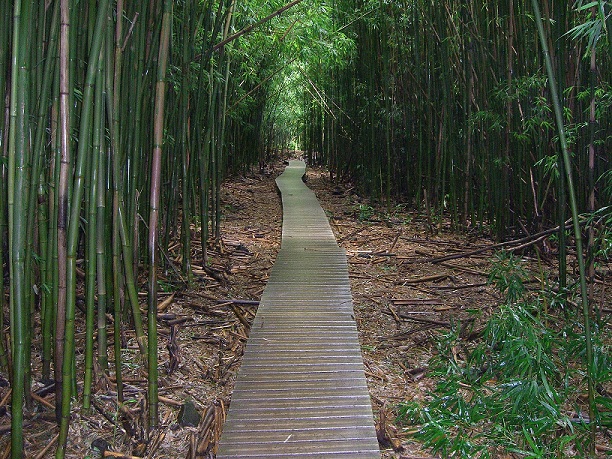
The adventure begins immediately upon stepping onto the trail, where you are greeted by the soothing sounds of rustling leaves and chirping birds. The first section of the trail winds through a tropical rainforest, with a canopy of towering trees offering intermittent shade. You’ll pass by vibrant guava trees, wild ginger, and ferns that thrive in the humid environment.
As you ascend, you’ll cross wooden footbridges over gently flowing streams, adding to the tranquil ambiance. The trail’s terrain alternates between packed dirt, wooden boardwalks, and rocky patches, making proper footwear essential.
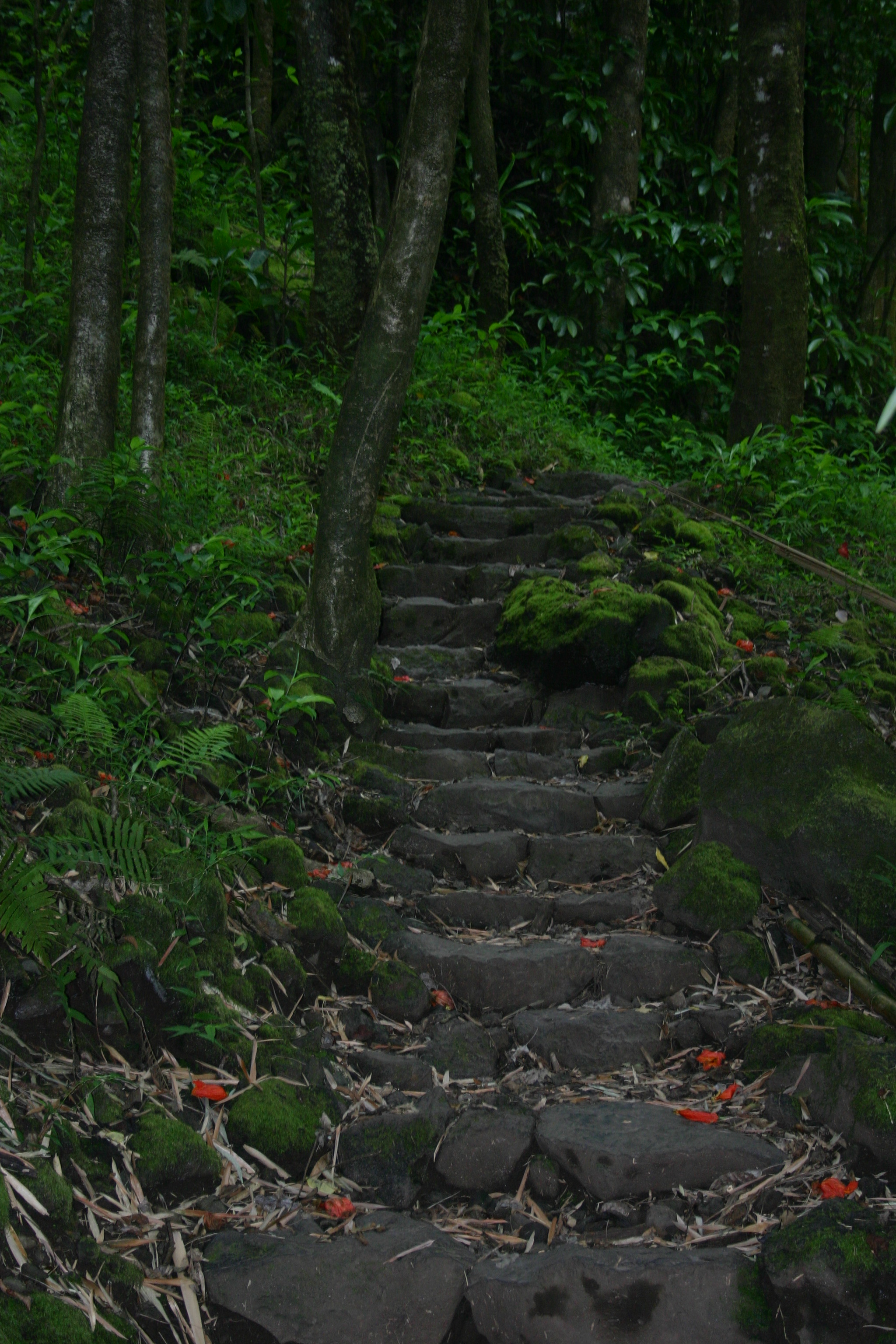
One of the most breathtaking highlights of the hike is the famous bamboo forest. About a mile into the trail, you’ll transition from the dense rainforest into an entirely different ecosystem. Towering bamboo stalks, some reaching over 60 feet high, form a striking tunnel-like corridor. The soft, filtered light creates an ethereal glow, especially during the morning hours.
As the wind passes through the grove, the bamboo stalks clatter gently, creating a calming, almost melodic sound. To protect the fragile forest floor, the park service has installed an elevated boardwalk that makes this section easy to navigate, even after rain. This stretch of the hike offers some of the most picturesque photo opportunities, with long, symmetrical lines of bamboo creating a magical atmosphere.
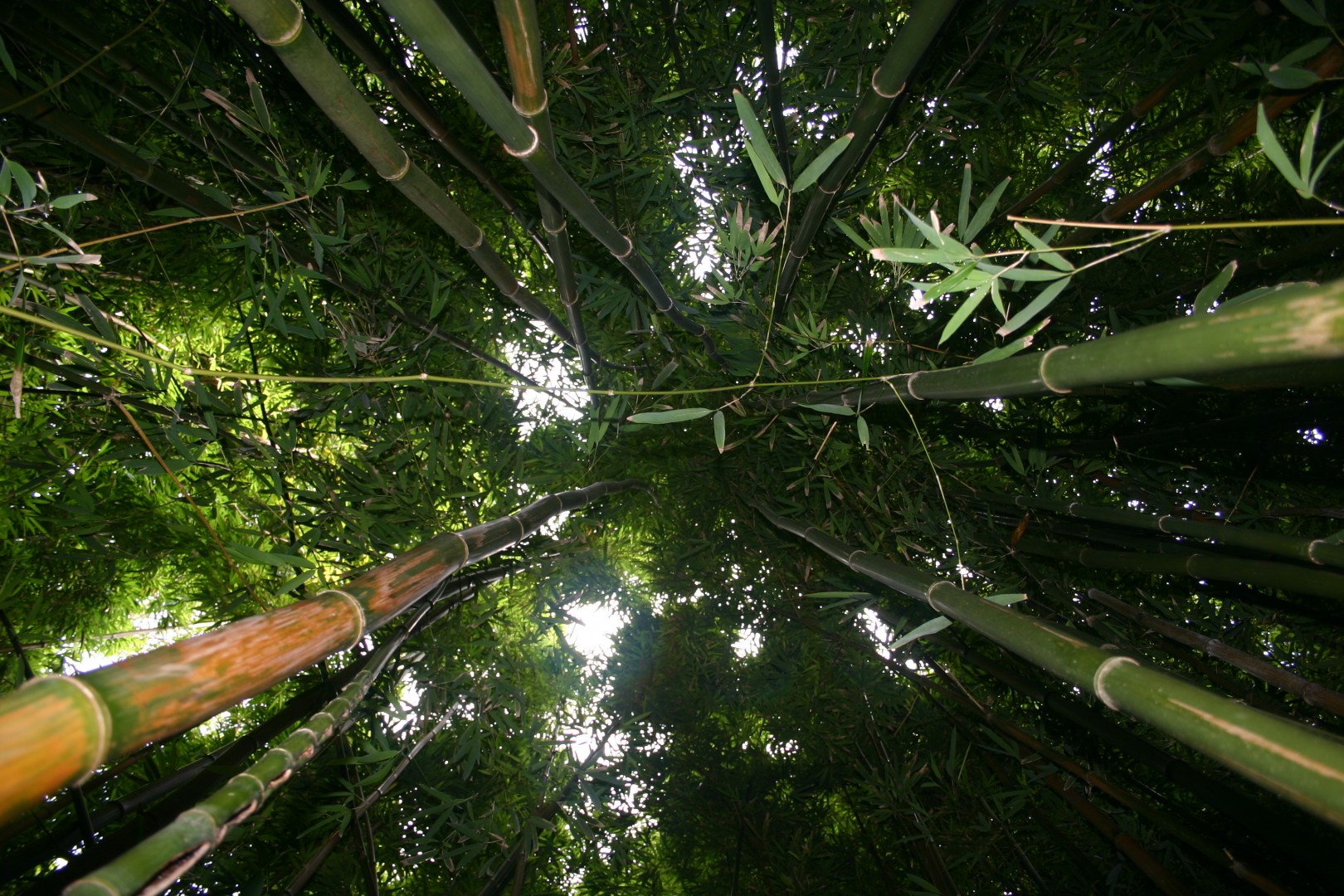
Roughly half a mile in, you’ll reach an overlook offering a spectacular view of Makahiku Falls, a 200-foot cascade that plunges into a hidden pool below. Though smaller than the final waterfall on the trail, Makahiku Falls is still a stunning sight. On sunny days, you may spot rainbows shimmering in the mist at the base of the falls.
This overlook provides a perfect spot to rest, hydrate, and snap some photos. However, resist the urge to venture off the trail—climbing closer to the falls or attempting to reach the pool below is dangerous and strictly prohibited.
The climax of the Pipiwai Trail is the awe-inspiring Waimoku Falls, which towers 400 feet over the lush rainforest below. The sight of this majestic waterfall cascading down a sheer lava rock wall is nothing short of breathtaking. The spray from the falls creates a refreshing mist, and the entire scene feels like something out of a dream.
The area around the falls is filled with large boulders and thick vegetation, creating a natural amphitheater. While it may be tempting to approach the waterfall or wade into the pool below, it is strongly discouraged due to the risk of falling rocks, which can be fatal. Instead, enjoy the view from a safe distance and take in the grandeur of one of Maui’s most iconic natural wonders.
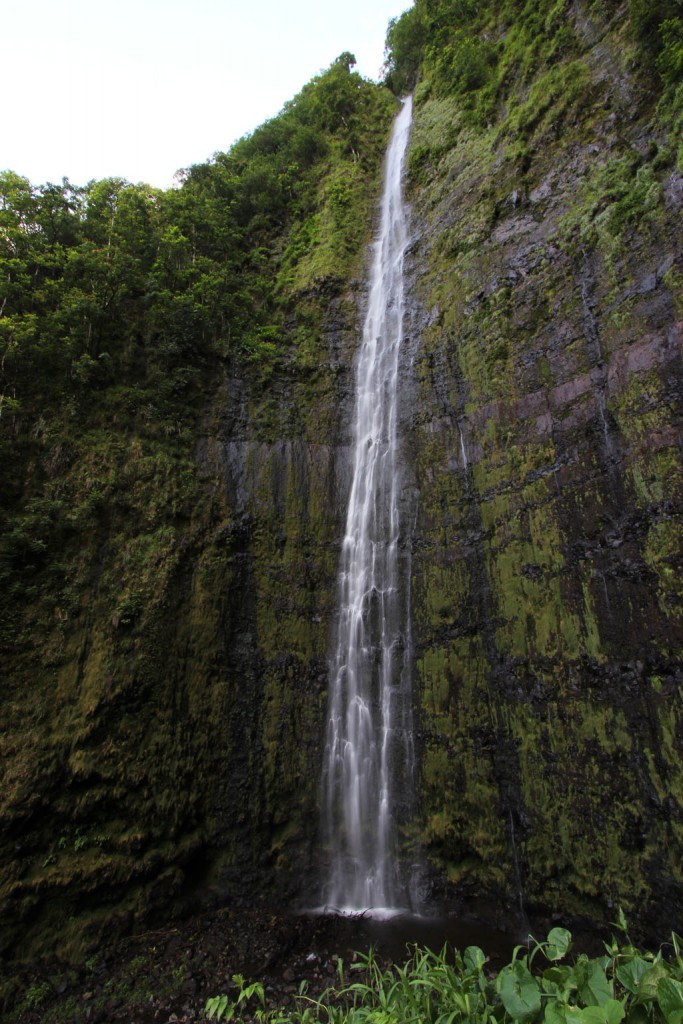
The Pipiwai Trail is open year-round, but the best time to visit is during the dry season (April to October) when the weather is more predictable and the trail conditions are drier. During the wet season (November to March), the trail can become muddy and slippery, and flash floods are more common, making stream crossings dangerous.
For the most enjoyable experience:
The Pipiwai Trail is a dream for photographers, offering diverse and stunning scenery at every turn. Some of the best photo opportunities include:
For the best lighting, aim to start your hike early in the morning or later in the afternoon, when the sun casts a golden glow through the bamboo forest.
While the Road to Hana offers plenty of scenic stops and short trails, the Pipiwai Trail is a standout experience that showcases the true beauty of Maui’s tropical landscape. From the serene rainforest paths to the awe-inspiring waterfalls, every section of this trail is a testament to Hawaii’s natural splendor.
Whether you’re chasing waterfalls, marveling at the enchanting bamboo forest, or simply enjoying the peaceful sounds of nature, the Pipiwai Trail offers a soul-stirring adventure that will leave you with lasting memories.
along the rugged coastline of Hana, Maui, lies one of the island’s most captivating and hidden treasures: Kaihalulu Beach, more commonly known as Red Sand Beach. Famous for its striking crimson shoreline, jagged lava cliffs, and the serene, turquoise waters of the Pacific, this secluded beach offers a breathtaking escape for adventurers, photographers, and nature enthusiasts alike.
Visiting Red Sand Beach is more than just a stop on a travel itinerary—it’s an experience that engages all the senses, from the sight of its vibrant hues to the sound of the waves crashing against the volcanic rocks. Whether you’re hiking in for a scenic adventure, seeking a peaceful spot to reflect, or simply marveling at nature’s artistry, Red Sand Beach is a must-see gem on the island of Maui.
What makes Red Sand Beach truly extraordinary is its unique geological makeup. The beach’s distinctive reddish hue comes from the crumbling volcanic cinder cone that encircles the cove. The cinder cone, rich in iron oxide, erodes over time, depositing iron-rich sediment that gives the beach its deep, rust-colored sand.
The surrounding cliffs, composed of jagged lava rock, add to the beach's dramatic landscape. Their dark, rugged appearance contrasts with the vibrant red shoreline and the emerald-green foliage clinging to the rocks. The interplay of colors creates a scene that feels almost otherworldly—a place where nature’s raw beauty is on full display.

Part of the allure of Red Sand Beach lies in its secluded and somewhat challenging accessibility. Unlike Maui’s more popular beaches, reaching this hidden gem requires a short but adventurous hike.
Trail Details:
Tips for a Safe and Enjoyable Hike:
✅ Footwear Matters: Wear sturdy shoes with good traction. Flip-flops are not recommended, as the loose, gravelly sections can be slippery.
✅ Exercise Caution: The trail runs alongside steep cliffs, making it potentially hazardous, especially after rainfall when the path becomes muddy and slick. Walk carefully and avoid getting too close to the edge.
✅ Travel Light: Since the hike is short, you don’t need to bring much. However, pack essentials like water, sunscreen, and a towel.
✅ Respect Private Property: The beach lies on private land, but public access is generally allowed. Be respectful of the area and follow all guidelines.
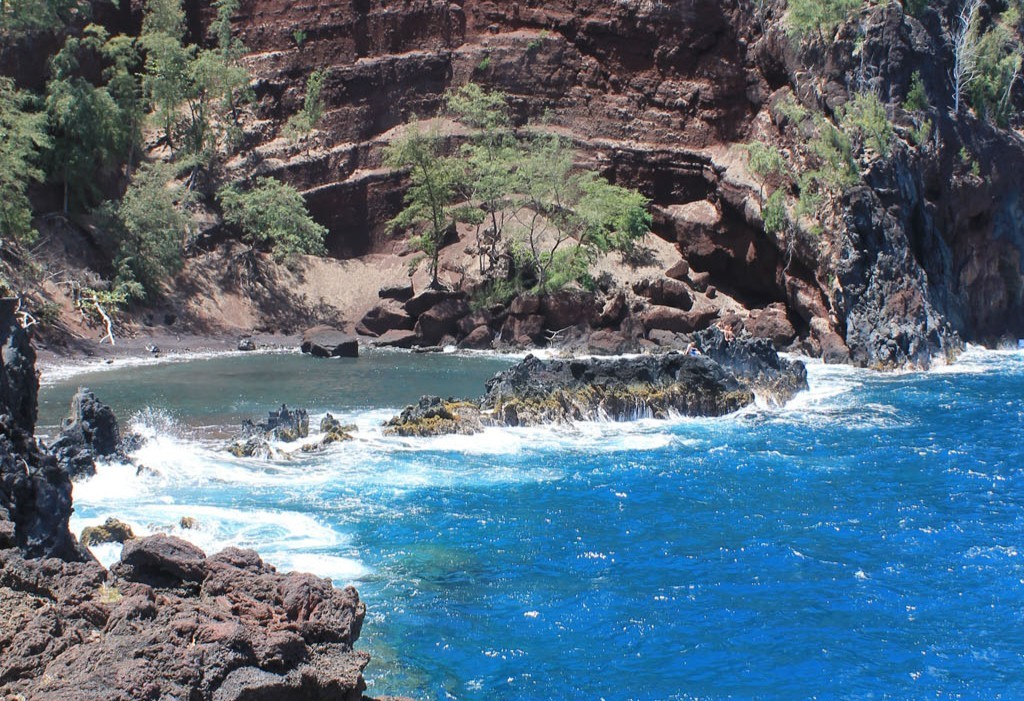
Once you arrive, you’ll be rewarded with a view that feels almost surreal. The crescent-shaped cove, embraced by steep lava rock cliffs, creates a sense of seclusion and intimacy. The beach’s vibrant red sand is soft underfoot, and the surrounding cliffs provide a natural wind barrier, making the cove feel peaceful and protected.
The offshore lava rock wall acts as a natural breakwater, creating a semi-protected swimming area with calmer waters—ideal for a relaxing dip. On calmer days, the water is clear and inviting, perfect for swimming or snorkeling.
Snorkeling Tip:
Bring your gear if you enjoy snorkeling. The reef area near the lava rock wall is home to colorful tropical fish, though visibility can vary depending on ocean conditions.
However, it’s important to note that Red Sand Beach does not have lifeguards. The water can sometimes be unpredictable, and strong currents are possible, especially beyond the protected cove. If you’re not a strong swimmer, it’s best to stay close to the shore and avoid venturing into deeper waters.
For photographers, Red Sand Beach offers endless visual inspiration. The contrast of the red sand against the blue sea and the green vegetation creates a scene that seems almost too vivid to be real.
Whether you’re capturing wide-angle shots of the entire cove or focusing on the intricate patterns in the sand, this beach offers stunning photo opportunities.
Maui’s tropical climate makes Red Sand Beach accessible year-round, but some times are better than others for a more enjoyable experience.
As with all natural wonders, it’s vital to respect and preserve the pristine environment of Red Sand Beach.
By following these guidelines, you can help keep this hidden treasure beautiful for future visitors.
Red Sand Beach in Hana, Maui, is more than just a picturesque destination—it’s a place of wonder and adventure. From the rugged hike through volcanic terrain to the vibrant, iron-rich sands and tranquil waters, the experience is nothing short of magical.
Whether you’re an avid hiker, a photographer seeking the perfect shot, or simply someone who appreciates the beauty of nature, Red Sand Beach offers an unforgettable escape. As you breathe in the salty air, feel the soft red sand beneath your feet, and gaze out at the endless Pacific, you’ll understand why this beach is one of Maui’s most treasured hidden gems. 🌴🏖️
Maui, the second-largest island in Hawaii, is known for its pristine beaches, lush rainforests, and vibrant culture. But just a few miles off its southern coast lies one of its most breathtaking natural wonders: Molokini Crater. This crescent-shaped, partially submerged volcanic caldera is a world-renowned snorkeling and diving destination, drawing visitors with its crystal-clear waters, vibrant marine life, and unique geological formations.
Molokini stands out from other snorkeling spots for several reasons:
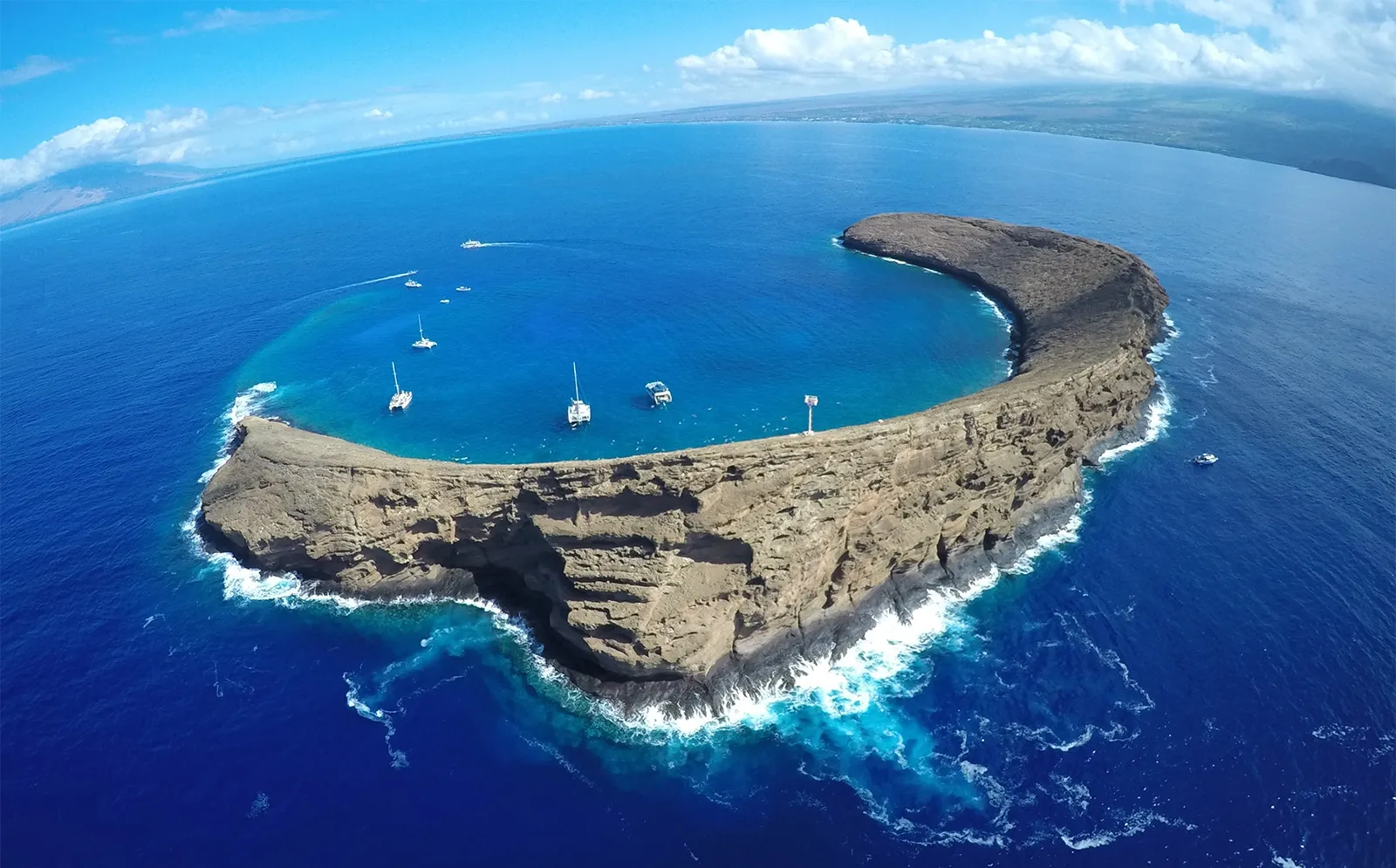
Most snorkeling tours to Molokini Crater depart from Maalaea Harbor or Kihei Boat Ramp. The boat ride takes approximately 20-45 minutes, depending on weather conditions. Tour operators typically provide:
Many tours make a second stop at Turtle Town, a nearby reef where Hawaiian green sea turtles are frequently spotted.
While snorkeling in Molokini’s pristine waters, you’ll have the chance to encounter a dazzling array of marine life, including:
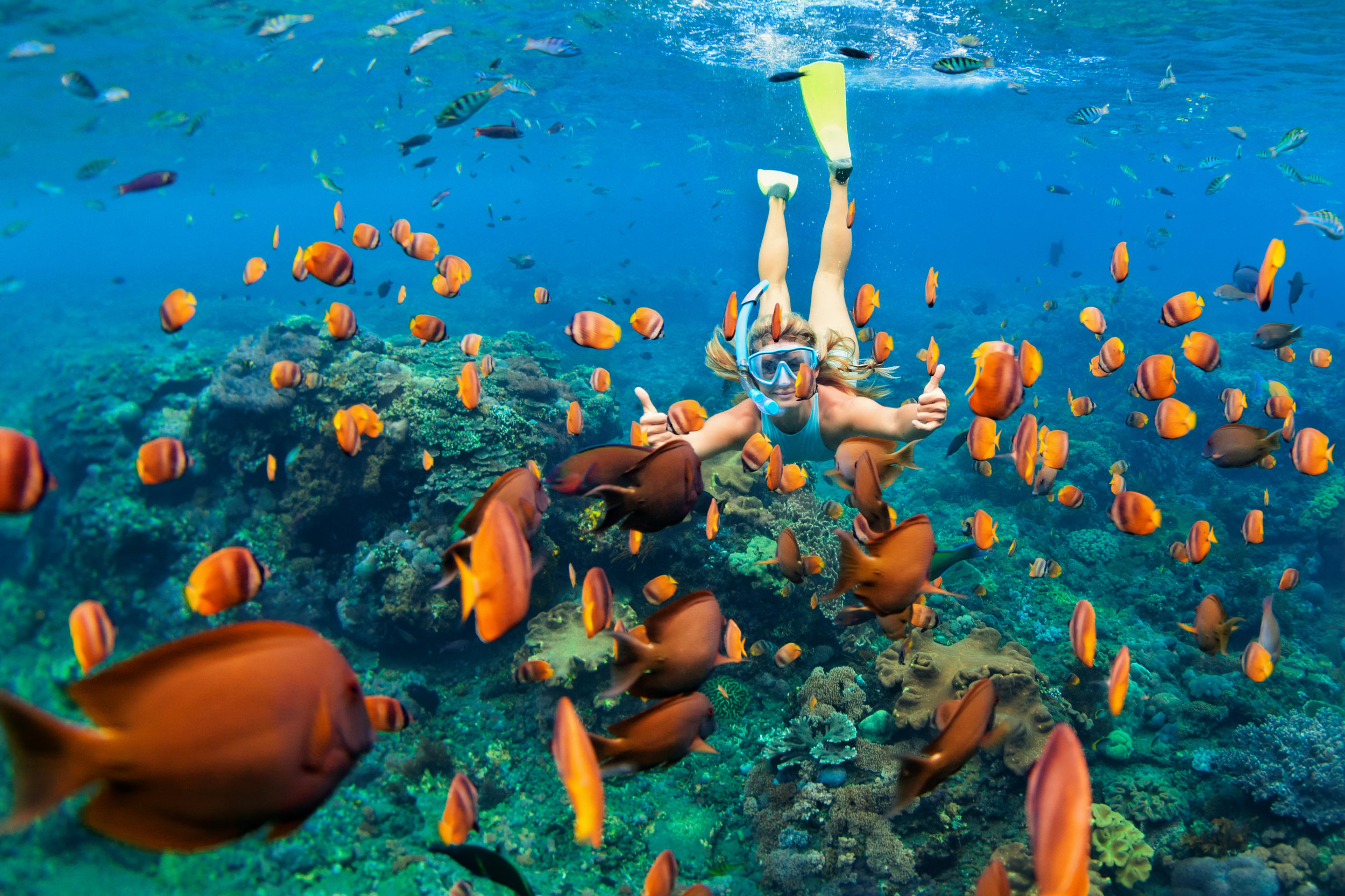
When selecting a snorkeling tour, consider:
Snorkeling at Molokini Crater is a must-do experience for anyone visiting Maui. Whether you’re a first-time snorkeler or an experienced underwater explorer, the crater’s serene waters and thriving marine life make for an unforgettable adventure. With its remarkable visibility, vibrant reefs, and peaceful ambiance, Molokini offers a rare glimpse into Hawaii’s mesmerizing underwater world.
👉 Pro Tip: For the best experience, consider booking your tour in advance, as Molokini excursions are popular and often sell out quickly.
Here is a great link to consider the many different tour options that awaits you! :
Viator Book HERE!
Perched along the iconic Hana Highway, Twin Falls is a captivating stop that offers a glimpse into Maui’s raw and untouched beauty. Known for its accessible trails, cascading waterfalls, and inviting swimming holes, it’s a favorite among both locals and visitors seeking a refreshing and picturesque retreat.
Twin Falls is located at Mile Marker 2 on the Hana Highway (Route 360), just a short drive from the town of Paia. The falls are part of the Ho’olawa Valley, a lush area fed by abundant rainfall, resulting in the steady flow of freshwater streams and waterfalls.
Here is a link to the Google Maps location for easy access and directions!
https://goo.gl/maps/Qa7i1HwUH492
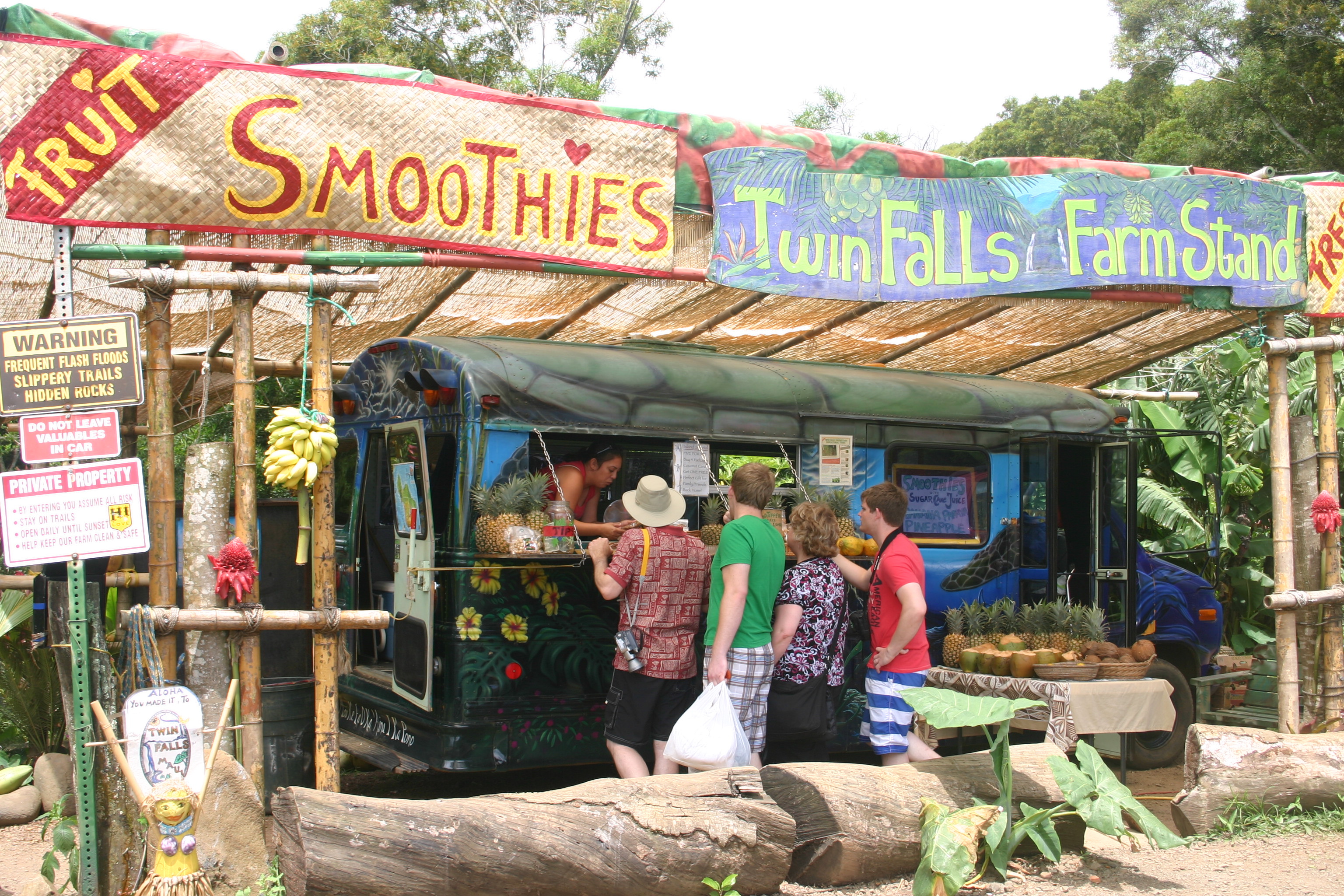
There is a small parking area at the trailhead, often bustling with cars, especially during midday. An on-site farm stand offers locally grown fruits, smoothies, coconut candy, and the famous fresh-baked banana bread—perfect for a pre- or post-hike snack.
The trail to Twin Falls is relatively short and moderate in difficulty, making it ideal for families and casual hikers. The well-trodden path winds through a tropical landscape of towering bamboo, wild ginger, and vibrant ferns. The surrounding area has recently gone through some renovation, making the trails a lot nicer and easier to traverse. The fauna also has been cleaned and new additions were added, adding to the breathtaking scenery.
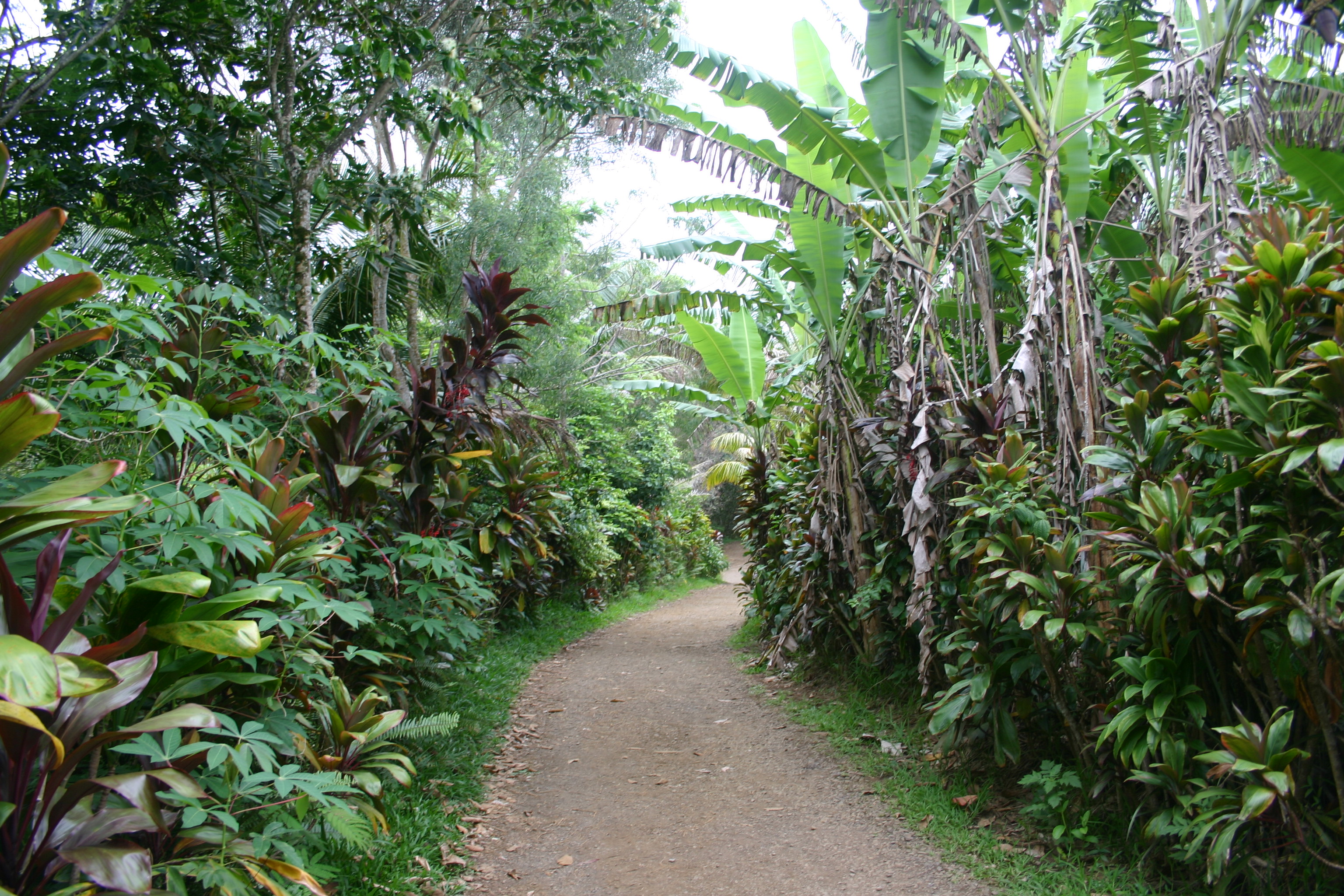
The first of three waterfalls is just a short walk from the trailhead. It’s easy to access and features a calm swimming hole surrounded by mossy rocks and overhanging vines. This spot is perfect for a quick dip or simply relaxing by the water’s edge. Then a few minute walk upward lands you at the second waterfall area, filled with a whole different vibe adding to its own personality. Continuing the adventure upward you come to one of the more striking waterfalls. Which you are able to access from both sides. Jumping in, sitting in the waterfall, or sunbathing on the rocks below... this waterfall is a local favorite for a reason. Alongside this waterfall stands a gate, and this gate leads to more wonders.
For those seeking a bit more adventure, the trail after passing the gate continues to a few more hidden waterfalls. Though slightly more challenging to reach, the reward is worth it. This cascade plunges into a deeper pool, ideal for swimming or wading beneath the rushing water + the beautiful natural Hawaii fauna makes this adventure one for the books. Be mindful to not pass the gate if its closed as in that means the water level is too high. At some point you will need to cross the little river, so be weary of the gate if it is closed.
To fully enjoy your Twin Falls adventure, consider packing the following:
Whether you’re floating in the cool waters, hiking through the dense jungle, or simply sitting by the falls, Twin Falls offers a tranquil and magical escape from the bustle of daily life. Its combination of scenic beauty, accessible trails, and refreshing swimming holes makes it a must-visit destination for anyone exploring Maui’s Hana Highway.
Next time you find yourself on Maui, take a moment to slow down and savor the serenity of Twin Falls—a place where the rhythm of flowing water and the scent of tropical blooms will leave you refreshed and inspired. 🌺
Check out the official Twin Falls Website here for more information!
https://www.twinfallsmaui.net/
Right along the picturesque northwest coast of Maui, Kapalua is a tropical paradise known for its luxurious resorts, world-class golf courses, and, most importantly, its stunning beaches. Whether you're looking for pristine white sand, crystal-clear waters, or excellent snorkeling opportunities, Kapalua’s beaches offer a little something for every type of beachgoer. There is too many gorgeous beaches and getaway's to choose from here in Kapalua. Here’s a look at the best beaches in Kapalua that should be on your must-visit list.
Arguably the most famous beach in the area, Kapalua Bay Beach is a crescent-shaped shoreline offering soft golden sand and calm waters. This beach is perfect for families and beginner snorkelers due to its gentle waves and abundant marine life. Snorkelers will find vibrant coral reefs teeming with tropical fish and even the occasional sea turtle. The bay is protected by two lava rock outcroppings, which help maintain its tranquil conditions year-round.
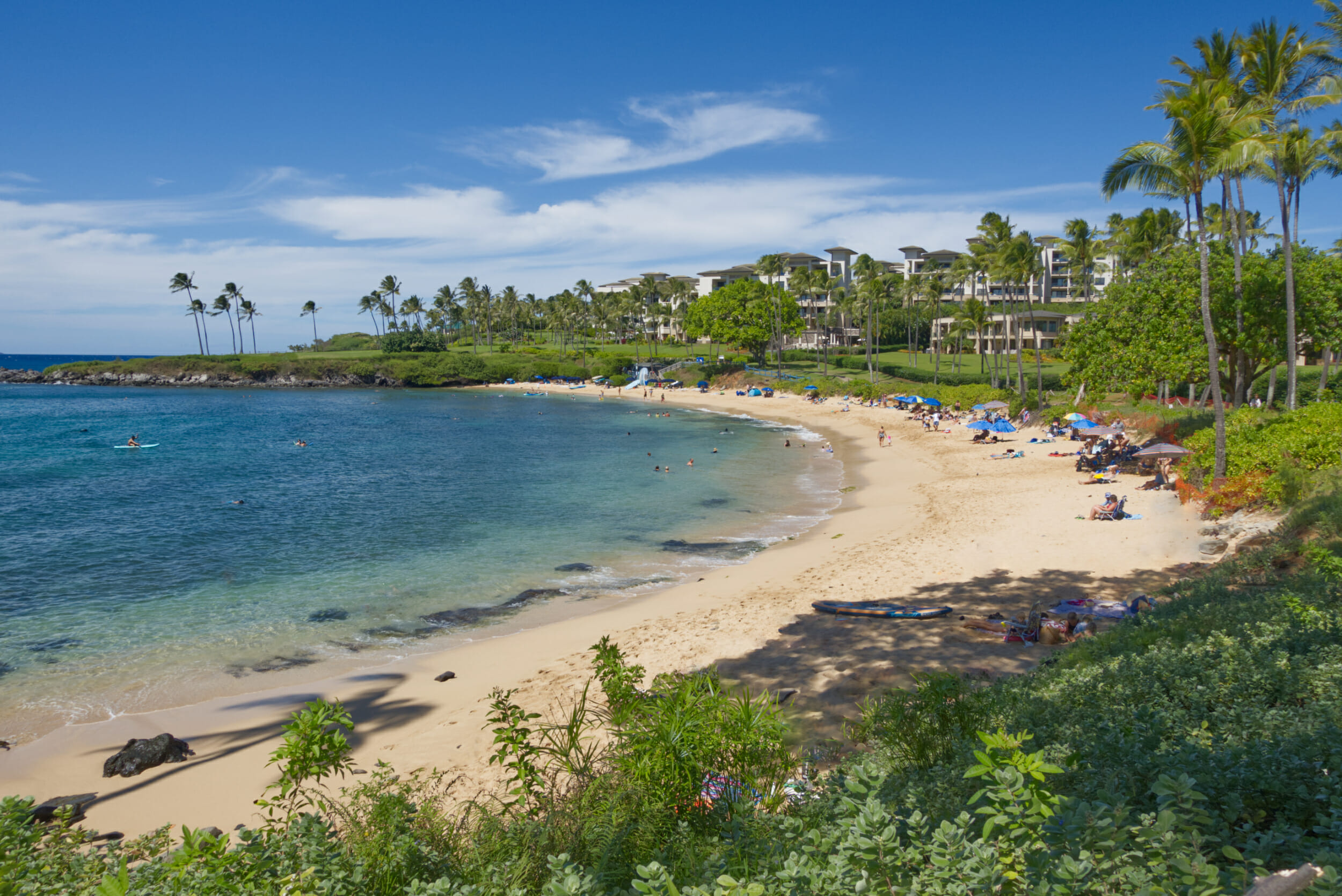
Located just north of Kapalua Bay, DT Fleming Beach Park is a favorite among both locals and visitors. This long, sandy beach is ideal for bodyboarding and surfing, especially during the winter months when the waves pick up. This world-class beach offers a more secluded and less touristy experience compared to Ka’anapali Beach. However, during high surf, conditions can become hazardous, with strong rip currents and powerful waves, making it essential to exercise caution. The perks of this beach are the convenient amenities, including picnic tables, restrooms, and lifeguards on duty, making it a great spot for a fun and safe beach day.
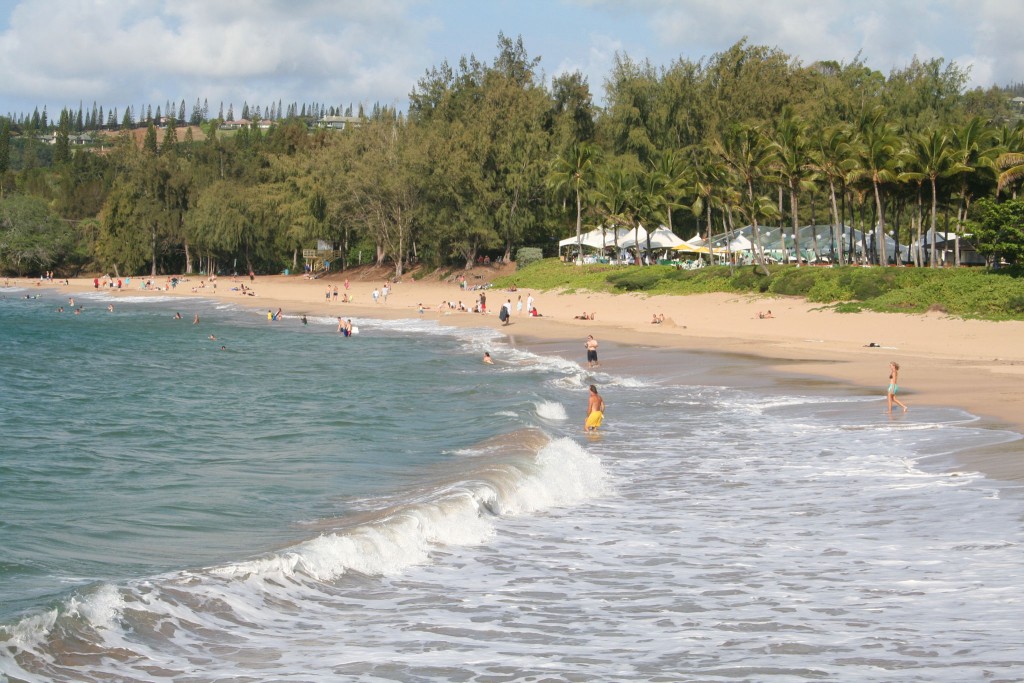
For those seeking a more secluded and peaceful setting, Oneloa Beach, also known as Ironwoods Beach, is a hidden gem. This pristine beach stretches along the rugged Kapalua coastline, offering breathtaking views and a more tranquil atmosphere. While the surf can be rough at times, it’s a fantastic spot for long walks, sunbathing, and photography. At the eastern end of the beach, where the parking lot path leads you, a shallow reef often becomes exposed along the shoreline. Many visitors mistakenly assume this rocky section extends across the entire beach and turn back too soon. Don’t make the same mistake—venture further down, and you’ll find a sandy-bottomed area perfect for wading and swimming.
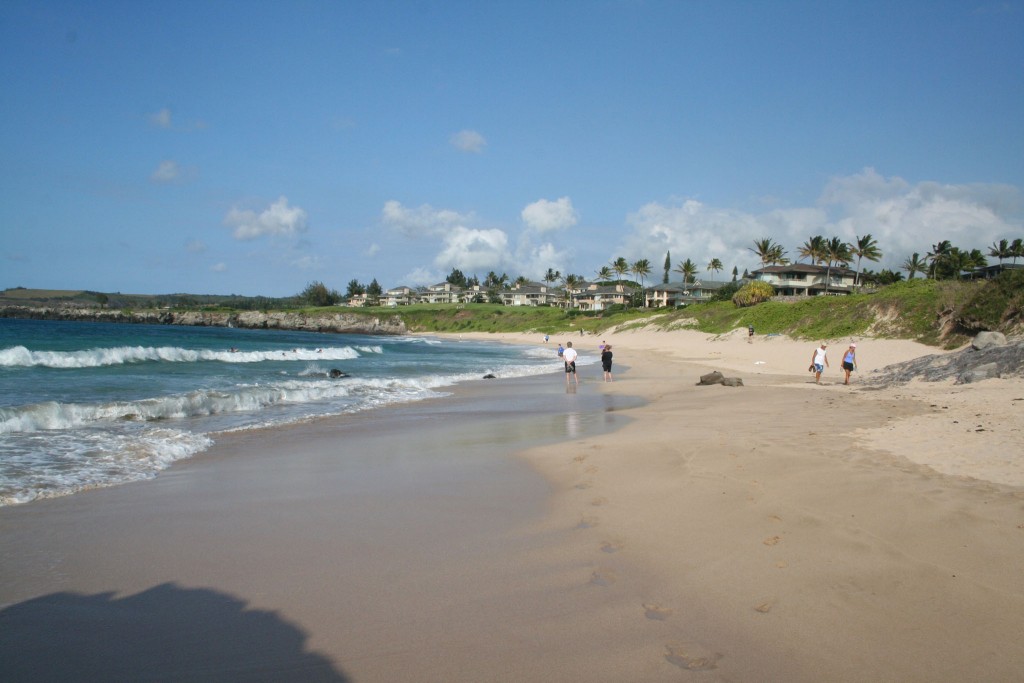
A short drive from Kapalua stands Honolua Bay, a world-renowned snorkeling and diving destination. Honolua Bay is part of a marine conservation district, framed by dramatic cliffs and lush vegetation. Its rocky shoreline is the result of powerful ocean currents that have long washed away fine sand particles, leaving behind a bed of smooth volcanic rocks and coral rubble. Additionally, the bay’s calm, deep waters and the lack of strong wave action prevent the accumulation of new sand, making it a haven for snorkelers and divers rather than sunbathers.
This absence of sand plays a crucial role in maintaining the bay’s pristine underwater ecosystem. Without the shifting sands to cloud the water, visibility remains excellent, allowing for an up-close view of vibrant coral reefs and diverse marine species; however, In the winter, Honolua Bay transforms into a top-tier surfing spot, attracting experienced surfers from around the world. Honolua Bay is a testament to the raw, untouched beauty of Maui’s coastline—a must-visit for nature lovers seeking an unspoiled underwater paradise.
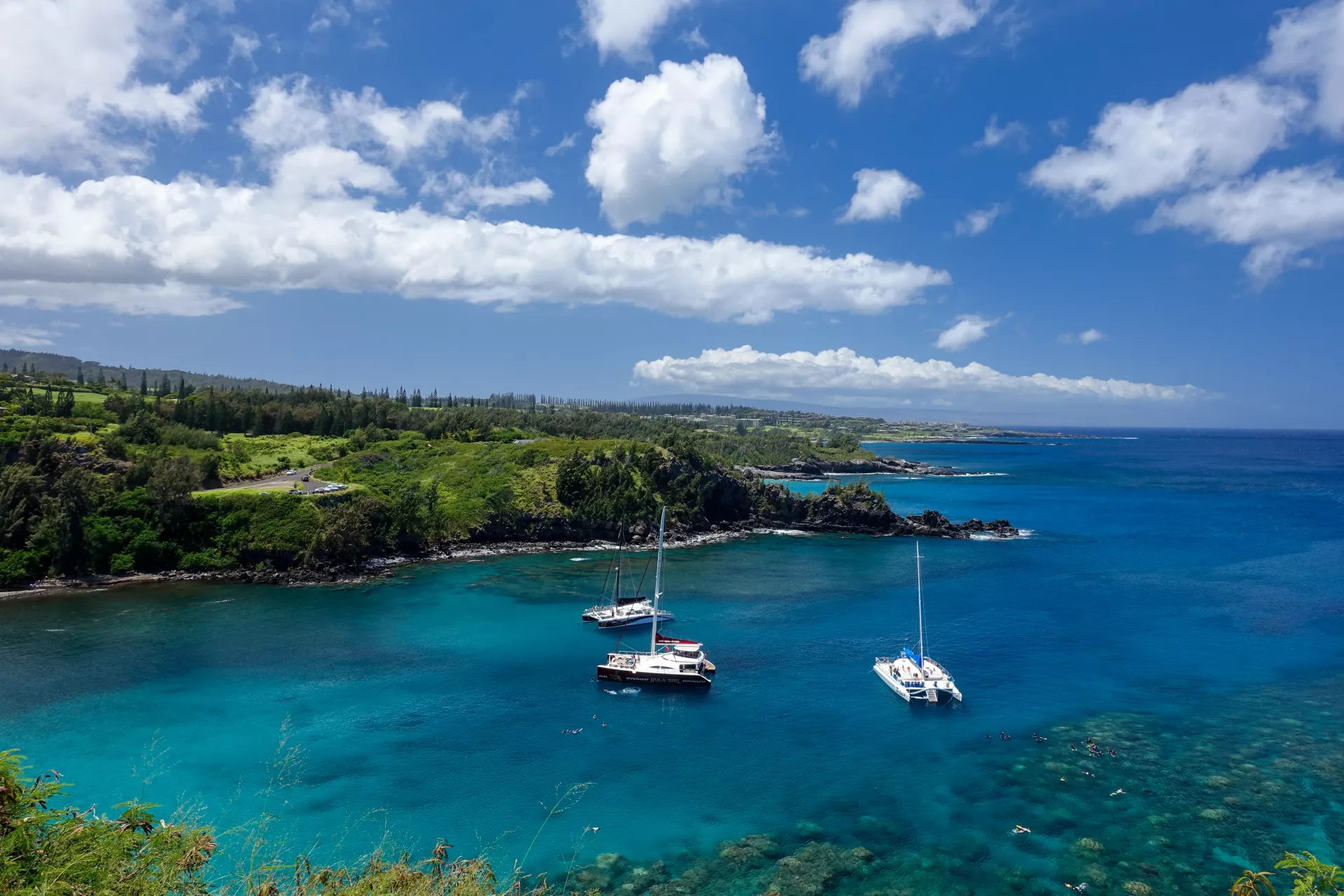
Just around the corner from Honolua Bay, Mokuleia Bay, often referred to as Slaughterhouse Beach, is another stunning option for those who love natural beauty. An amazing beach for surfers and bodyboarders in the winter time. This beach is slightly more difficult to access, requiring a short hike down a set of stairs, but it rewards visitors with soft sand, clear waters, and excellent snorkeling opportunities. Mokule‘ia Bay, part of the Honolua-Mokule‘ia Bay Marine Life Conservation District, shares its protected waters with its northern neighbor, Honolua Bay. However, unlike Honolua’s rocky shoreline, Mokule‘ia Bay offers a beautiful sandy beach for much of the year, making it an ideal spot to unwind and soak in Maui’s natural beauty. During the summer, the calm waters make it a great spot for swimming, while winter months bring powerful waves that draw experienced surfers.
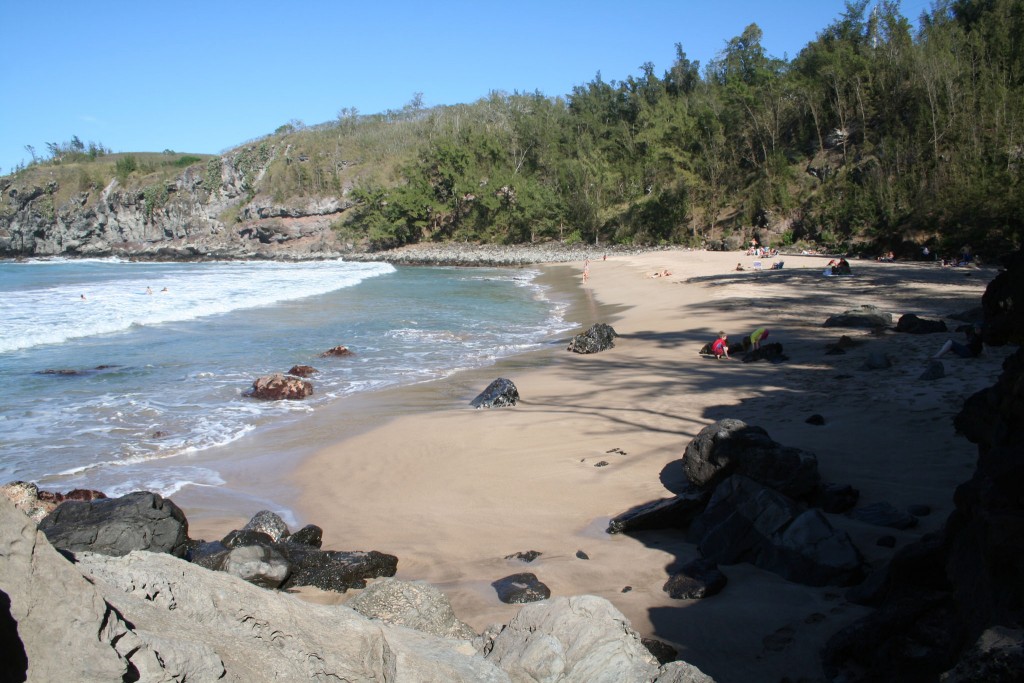
Kapalua’s beaches are among the most beautiful in all of Hawaii, offering something for every kind of beach enthusiast. Whether you’re looking for relaxation, adventure, or breathtaking scenery, these beaches will not disappoint. Be sure to bring reef-safe sunscreen, respect the local marine life, and enjoy the natural wonders that make Kapalua a true paradise.
Located right in Waikapu, Maui Tropical Plantation is a must-visit destination for those looking to experience the island’s lush landscapes, rich agricultural history, and vibrant cultural heritage. Spanning 500 acres, this beautiful plantation offers visitors an immersive look into Hawaii’s tropical agriculture while providing a serene escape into nature.
Maui Tropical Plantation is more than just a scenic retreat—it is a living, breathing testament to Hawaii’s farming traditions. Guests can embark on the popular Tropical Express Tour, a guided tram ride through the plantation’s sprawling fields. Along the way, visitors will witness a variety of tropical crops, including coffee, papaya, coconut, mango, and taro, while learning about their significance in Hawaiian culture and history.

Since its establishment in 1983, Maui Tropical Plantation has been a premier destination for visitors seeking to learn about the island’s rich agricultural traditions. Originally designed to showcase how Maui’s crops are grown, the plantation continues to offer an immersive and educational experience today.
One of the highlights of a visit is the 45-minute tram tour, where local guides lead guests through the plantation’s sprawling 1,500 acres, featuring an impressive variety of 65 crops. Among the lush fields, visitors can see and learn about pineapple, banana, papaya, starfruit, coffee, guava, coconut, macadamia nuts, taro, avocado, and even newly introduced sunflowers—a recent addition to Maui’s agricultural landscape. Seasonal variations ensure that each tour offers something unique.
The tram tour operates hourly from 10 AM to 4 PM, providing ample opportunities to explore the plantation’s beauty. Tickets can be purchased conveniently at the Plantation Store entrance or online.
https://mauitropicalplantation.com/tour-tickets
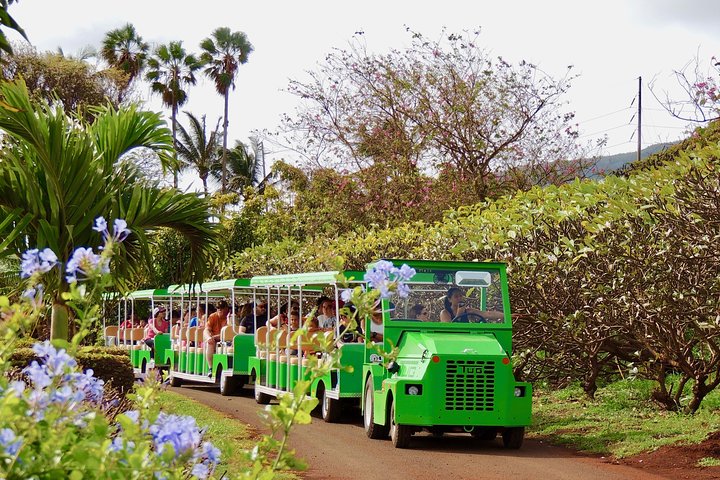
Maui Tropical Plantation provides a variety of interactive experiences that appeal to visitors of all ages. Whether you’re seeking adventure or a deeper appreciation of Hawaiian farming traditions, the plantation offers something for everyone. For thrill-seekers, the plantation’s zipline course provides an exhilarating way to take in the stunning surroundings. As you soar above the lush fields, you’ll be treated to a breathtaking bird’s-eye view of the towering palm trees, tropical crops, and vibrant floral gardens. The zipline is designed to be both exciting and family-friendly, making it a must-try experience for those looking to add a bit of adrenaline to their visit.
For visitors interested in a more grounded, hands-on approach, the plantation offers engaging demonstrations that highlight traditional Hawaiian agricultural practices. One of the most popular activities is the coconut husking demonstration, where guests can witness firsthand the skill and technique required to open a coconut using time-honored methods. These demonstrations provide an educational glimpse into Hawaiian farming heritage, connecting guests to the island’s deep-rooted agricultural traditions.
A Culinary Delight
A visit to Maui Tropical Plantation wouldn’t be complete without savoring the flavors of the island at The Mill House restaurant. Known for its farm-to-table dining, The Mill House sources fresh ingredients directly from the plantation and local farmers. Guests can indulge in exquisite dishes that highlight the island’s seasonal bounty while enjoying breathtaking views of the West Maui Mountains or Mauna Kahālāwai.
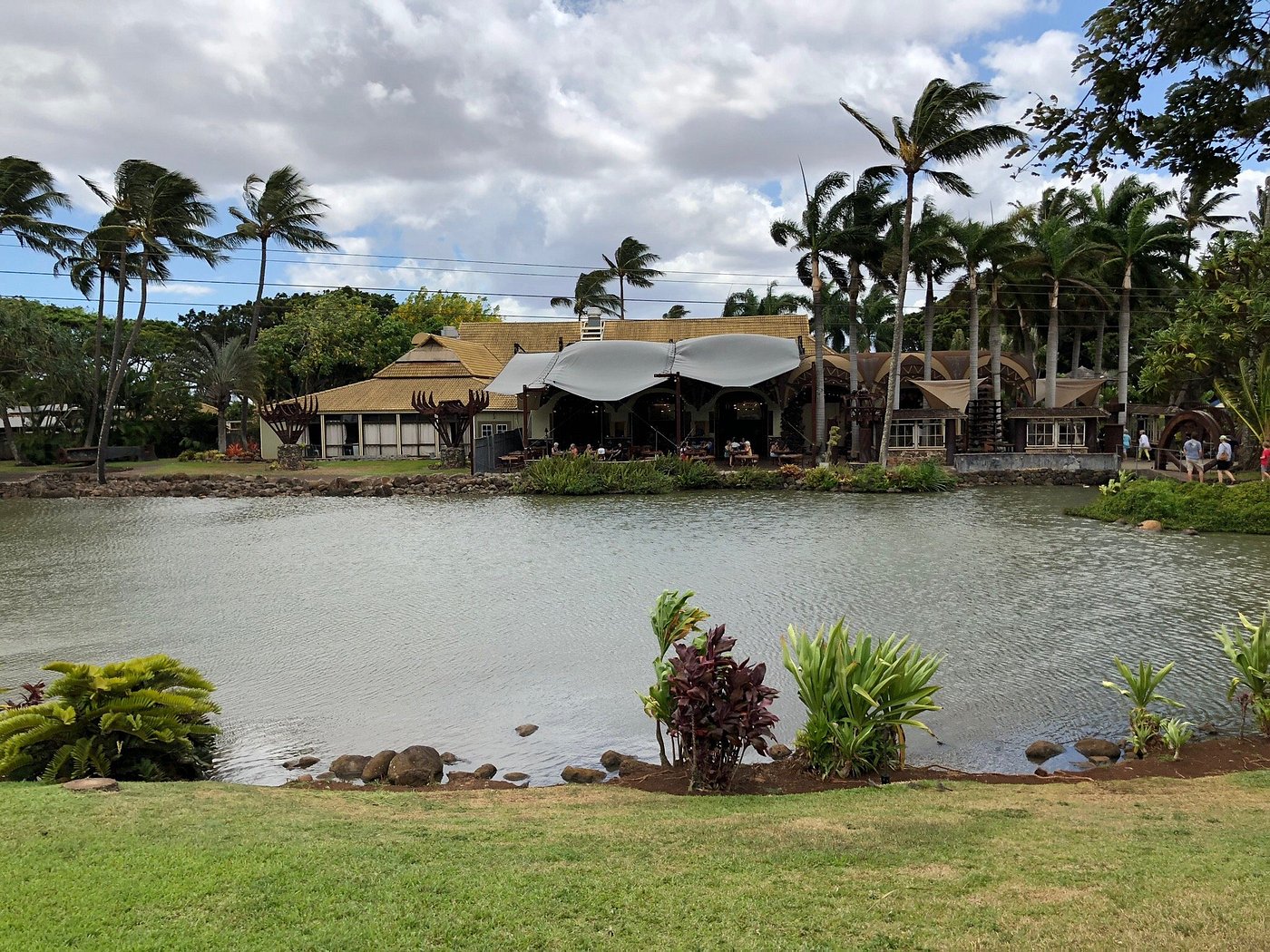
Maui Tropical Plantation is committed to sustainability and preserving the island’s agricultural heritage. Through eco-friendly practices and community engagement, the plantation plays a vital role in educating visitors about the importance of sustainable farming and environmental stewardship.
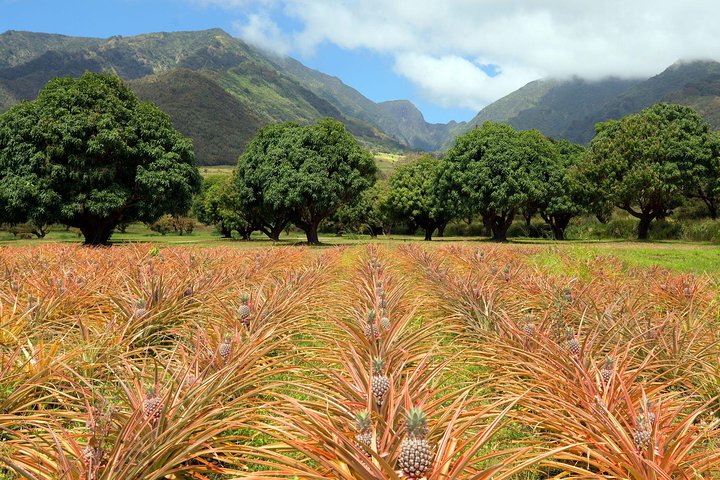
Whether you’re a first-time visitor to Maui or a returning traveler, Maui Tropical Plantation offers a unique blend of adventure, history, and relaxation. With its stunning landscapes, engaging experiences, and dedication to preserving Hawaii’s agricultural traditions, it remains a cherished destination for all who seek to explore the beauty of the island.
Discover the heart of Maui—visit Maui Tropical Plantation and experience the island’s agricultural paradise firsthand.